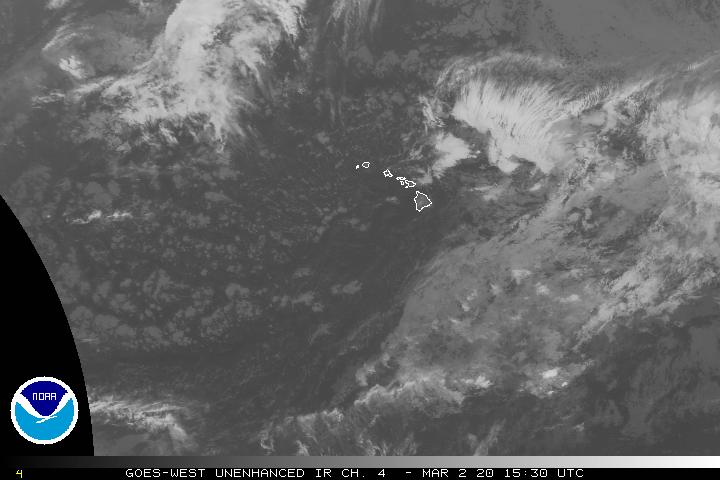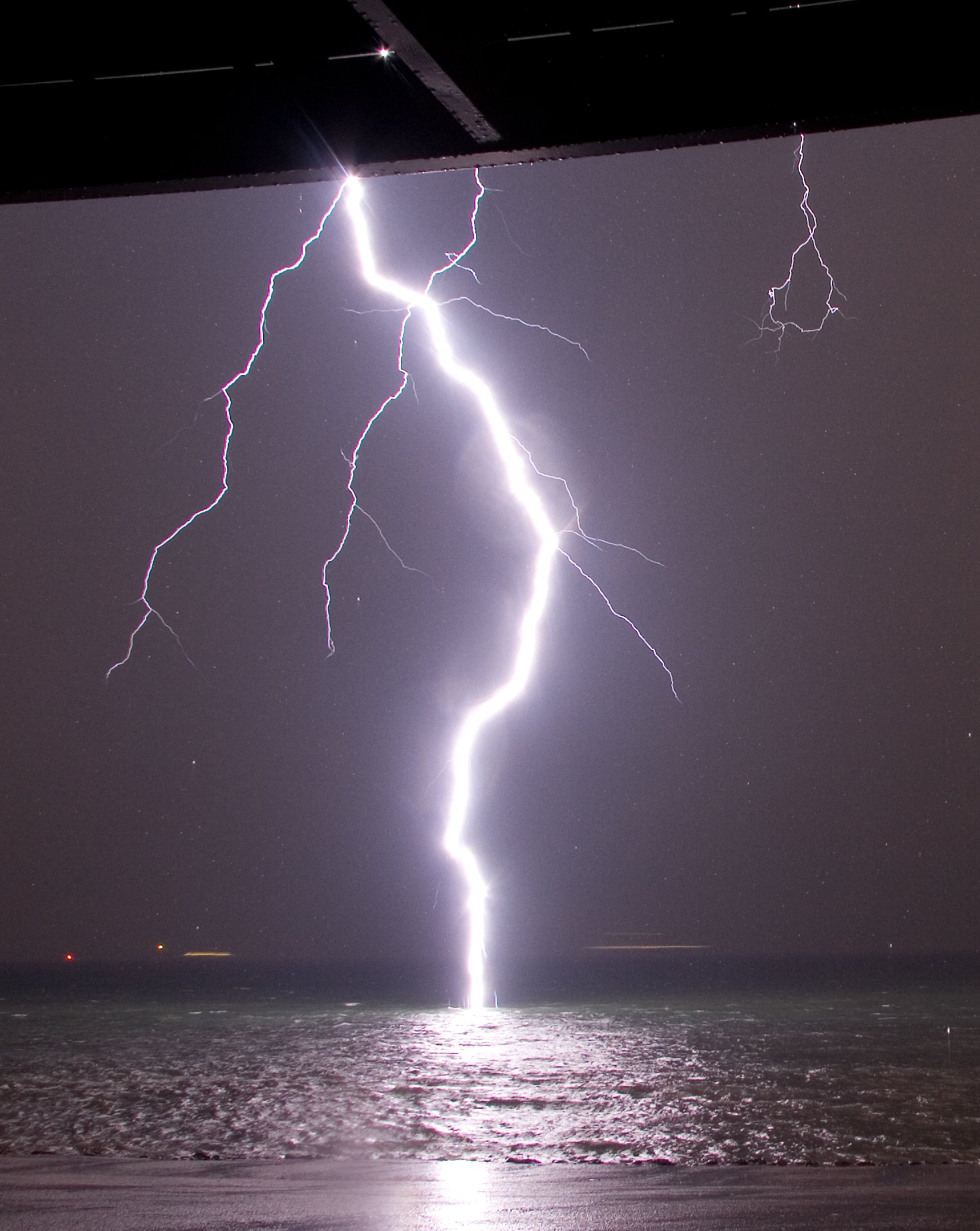Air Temperatures – The following maximum temperatures (F) were recorded across the state of Hawaii Wednesday…along with the minimums Wednesday:
77 – 65 Lihue, Kauai
77 – 66 Honolulu, Oahu
75 – 66 Molokai AP
80 – 69 Kahului AP, Maui
83 – 71 Kailua Kona
81 – 66 Hilo AP, Hawaii
Here are the latest 24-hour precipitation totals (inches) for each of the islands, as of Wednesday evening:
0.09 Kilohana, Kauai
0.02 Hakipuu Mauka, Oahu
0.06 Puu Alii, Molokai
0.00 Lanai
0.00 Kahoolawe
0.14 West Wailuaiki, Maui
0.34 Saddle Quarry, Big Island
The following numbers represent the strongest wind gusts (mph)…as of Wednesday evening:
18 Mana, Kauai – NNW
28 Oahu Forest NWR, Oahu – S
12 Molokai – ENE
23 Lanai – NE
27 Kahaloowe – NE
23 Kapalua, Maui – N
24 Kealakomo, Big Island – NE
Hawaii’s Mountains – Here’s a link to the live web cam on the summit of near 13,800 foot Mauna Kea on the Big Island of Hawaii. This web cam is available during the daylight hours here in the islands…and when there’s a big moon shining down during the night at times. Plus, during the nights you will be able to see stars, and the sunrise and sunset too…depending upon weather conditions.
Aloha Paragraphs

Deep storm far north of Hawaii…in the Gulf of Alaska

Scattered thunderstorms and high cirrus clouds to our south

Clear to partly cloudy…some cloudy areas

A few showers…mostly light and scattered around
the eastern islands – looping radar image
High Surf Warning…a very large northwest swell will
cause hazardous surf conditions today
High Surf Advisory…Olomana, Kona, north and east Kohala
Small Craft Advisory…for a large northwest swell causing
elevated seas
~~~ Hawaii Weather Narrative ~~~
Light trade winds…giving way to light and variable breezes Thursday and Friday. Here’s the latest weather map, showing the Hawaiian Islands, and the rest of the North Pacific Ocean. We find high pressure systems northeast and west-northwest of the state. At the same time, there’s a ridge of high pressure just north of the islands. In addition, there’s numerous low pressure systems to the northeast through northwest of Hawaii. The tail-end of yesterday’s weak cold front remains just offshore to the southeast of the Big Island. We’ll find generally light winds through the weekend…along with these lighter winds, we’ll very likely see more volcanic haze collecting locally at times.
Here’s a wind profile…of the offshore waters around the islands – with a closer view
Here’s the Hawaiian Islands Sulfate Aerosol…animated graphic – showing vog forecast
A few windward showers tonight, with upcountry afternoon showers at times locally…Thursday into the weekend. The atmosphere over and around the islands now is quite dry and stable. This in turn will limit the intensity of any shower activity into the weekend. Looking ahead, the models continue to suggest we could finally see a more robust cold front moving into our area early next week. This next Tuesday-Wednesday front could bring a good increase in showers statewide. The models go on to point out the chance of a notable period of windy to very windy weather in the wake of that cold front…bringing a late winter chill our way for a day or two.
Marine environment details: A small craft advisory is posted for all Hawaiian coastal waters except Maalaea Bay, Maui, due to a large northwest swell affecting the islands…likely to be extended through at least Thursday. The next northwest swell will likely elevate seas to advisory levels again over exposed waters late Saturday into Sunday. A strong cold front during the middle of next week may bring small craft advisory winds and possibly gales to much of the marine area then.
The current northwest swell is expected to lower Thursday, but the high surf warning / advisory has been extended through the day Thursday. Another northwest swell event is expected over the weekend with advisory level surf returning to north and west facing shores of the smaller islands. A small, but noticeable, out of season, long period south swell is expected to arrive during the first half of next week.

Here in Maui County...It’s clear to partly cloudy early this Wednesday morning…and hazy. Here in upcountry Kula we have an air temperature of 46.5F degrees before sunrise. The temperature at near the same time was 72 degrees down in Kahului under cloudy skies, 68 out in Hana, 68 also at Maalaea Bay, and 43 atop the Haleakala summit. Meanwhile, Kahoolawe was 63 degrees, 64 at Lanai City, with 68 at the Molokai airport.
– It’s not long before sunset, under partly cloudy conditions…and still this thick haze! / Oh brrr, it’s 49.4 here at up my Kula weather tower…at an early 810pm! I wonder if this will be the coolest Thursday morning of the winter so far?
I’ll be back with many more updates on all of the above and below, I hope you have a great Wednesday night wherever you’re spending it! Aloha for now…Glenn

Lightening strikes water
World-wide tropical cyclone activity:
>>> Atlantic Ocean: The last regularly scheduled Tropical Weather Outlook of the 2015 Atlantic hurricane season…has occurred. Routine issuance of the Tropical Weather Outlook will resume on June 1, 2016. During the off-season, Special Tropical Weather Outlooks will be issued if conditions warrant. Here’s the 2015 hurricane season summary
Here’s a satellite image of the Atlantic Ocean
>>> Caribbean Sea: The last regularly scheduled Tropical Weather Outlook of the 2015 Atlantic hurricane season…has occurred. Routine issuance of the Tropical Weather Outlook will resume on June 1, 2016. During the off-season, Special Tropical Weather Outlooks will be issued if conditions warrant.
>>> Gulf of Mexico: The last regularly scheduled Tropical Weather Outlook of the 2015 Atlantic hurricane season…has occurred. Routine issuance of the Tropical Weather Outlook will resume on June 1, 2016. During the off-season, Special Tropical Weather Outlooks will be issued if conditions warrant.
Here’s a satellite image of the Caribbean Sea…and the Gulf of Mexico
Here’s the link to the National Hurricane Center (NHC)
>>> Eastern Pacific: The last regularly scheduled Tropical Weather Outlook of the 2015 North Pacific hurricane season…has occurred. Routine issuance of the Tropical Weather Outlook will resume on May 15, 2016. During the off-season, Special Tropical Weather Outlooks will be issued if conditions warrant. Here’s the 2015 hurricane season summary
Here’s a wide satellite image that covers the entire area between Mexico, out through the central Pacific…to the International Dateline.
Here’s the link to the National Hurricane Center (NHC)
>>> Central Pacific: The central north Pacific hurricane season has officially ended. Routine issuance of the tropical weather outlook will resume on June 1, 2016. During the off-season, special tropical weather outlooks will be issued if conditions warrant. Here’s the 2015 hurricane season summary
Here’s a link to the Central Pacific Hurricane Center (CPHC)
>>> South Pacific Ocean: There are no active tropical cyclones
>>> North and South Indian Oceans / Arabian Sea: There are no active tropical cyclones
Here’s a link to the Joint Typhoon Warning Center (JTWC)
Interesting: Virginia Tech researchers discover a royal flush in powering fuel cells with wastewater – As renewable energy sources go, solar rays have historically hogged the limelight.
But two Virginia Tech researchers have stolen the spotlight from the sun by discovering a way to maximize the amount of electricity that can be generated from the wastewater we flush down the toilet.
An article published in Scientific Reports detailing their findings speaks to a growing sustainability movement to capture energy from existing waste to potentially make treatment facilities more energy-efficient.
Xueyang Feng and Jason He traced bacteria, which led them to discover that the working relationship between two specific substrates produced more energy than either did separately. This work will help take the mystery out of how electrochemically-active bacteria create energy. It could help in the development of new treatment system called a microbial fuel cell.
“Tracing the bacteria gave us a major piece of the puzzle to start generating electricity in a sustainable way,” said Feng, an assistant professor of biological systems engineering. “This is a step toward the growing trend to make wastewater treatment centers self-sustaining in the energy they use.”
Feng is in the College of Agriculture and Life Sciences and the College of Engineering; He, an associate professor of environmental engineering, is in the College of Engineering.
The discovery is important because not all organics perform the same job in the same way. Some work because they are food for the electricity-generating bacteria while others are good at conducting energy.
While one substrate known as lactate was mainly metabolized by its host bacteria to support cell growth, another substrate known as formate was oxidized to release electrons for higher electricity generation.
The team found that when these two substrates are combined, the output of energy is far greater than when they are working separately. The organics work in tandem with receptors in fuel cells, and while research using microbial fuel cells is not new, the kind of organics that Feng and He used was novel in generating electricity because they were able to measure the symbiotic nature of two particular organics.
The unique methodology that allowed them to trace the metabolic pathways of the different strains of bacteria, called carbon 13 pathway analysis, was the first time this type of isotope labeling process was used in measuring metabolism in microbes, the researchers said. The analysis works by creating a non-radioactive isotope on a carbon group that is visible through a mass spectrometry.
Harnessing energy from wastewater is a sustainability measure that even urban plants such as the wastewater treatment facilities in Washington, D.C. have already adopted. Harnessing energy using bacteria in microbial fuel cells is not the only way researchers are looking at generating energy from waste.
Treatment plants are now able to harness methane from the solids in sewage allowing towns such as Grand Junction, Colorado, to generate energy. The plant takes in 8 million gallons of wastewater and is the first city in the U.S. to fuel its vehicle fleet with energy produced from human waste.
He’s research also includes work with gaseous elements, specifically ammonia. In wastewater, ammonia is a pollutant. If too much is discharged into a watershed, it feeds harmful algal blooms that can devastate aquatic ecosystems.
Mohan Qin, a second-year doctoral student in He’s lab, has built a system that recovers ammonia and removes other contaminants while generating electricity at the same time. This is the first time that ammonia-driven forward osmosis has been combined with an ammonia-generating microbial electrochemical cell, Qin said.
The idea earned Qin, who is from Shandong Province, China, the 2015 Innovation Award for Best Technological Advancement from the International Society for Microbial Electrochemistry and Technology.
The results of this work encouraged the further development of microbial fuel cells, especially system scaling up. The He lab is currently operating a 200-L microbial fuel cell system in a local wastewater treatment plant for evaluating its long term performance with actual wastes.
For now, however, Feng and He are not only giving wastewater its moment in the sun, they are making sure that, whether it’s ammonia or organic waste, that producing energy from wastewater is part of a movement.












 Email Glenn James:
Email Glenn James:
Eddi Miglavs Says:
Glenn – quick question: when you say “haze” do you mean “vog” or a different kind of haze?
Thank you.
~~~ Hi Eddi, that’s a good question. As the trade winds are blowing, I’d like to say it isn’t, and its probably marine haze from the large surf breaking along our north and west shores now. However, if I was forced to give an answer or else…I’d have to say it’s definitely volcanic haze!
We’ve had so much vog this year, and last year too…yuck! I feel for the folks who live in those areas of the Big Island, that have it way more than we do here in Maui County!
Aloha, Glenn